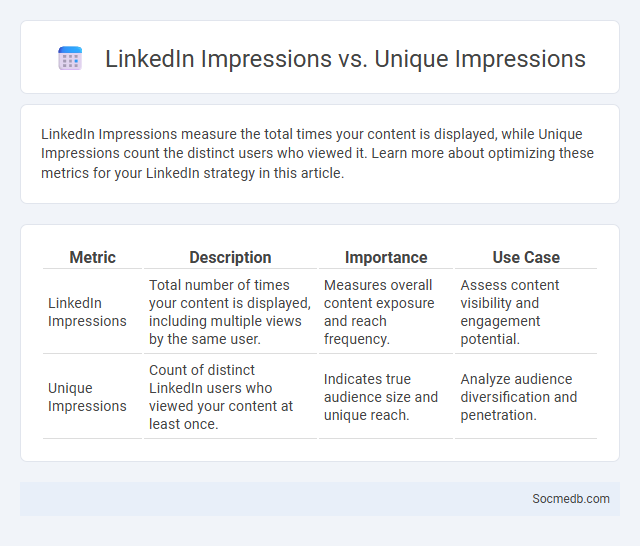
Photo illustration: LinkedIn Impressions vs Unique Impressions
LinkedIn Impressions measure the total times your content is displayed, while Unique Impressions count the distinct users who viewed it. Learn more about optimizing these metrics for your LinkedIn strategy in this article.
Table of Comparison
| Metric | Description | Importance | Use Case |
|---|---|---|---|
| LinkedIn Impressions | Total number of times your content is displayed, including multiple views by the same user. | Measures overall content exposure and reach frequency. | Assess content visibility and engagement potential. |
| Unique Impressions | Count of distinct LinkedIn users who viewed your content at least once. | Indicates true audience size and unique reach. | Analyze audience diversification and penetration. |
Understanding LinkedIn Impressions
LinkedIn impressions represent the number of times your content is displayed on users' screens, reflecting potential visibility and reach. Tracking impressions helps you measure the effectiveness of your posts and optimize your content strategy for better engagement. By analyzing trends in your LinkedIn impressions, you can tailor your activity to increase your professional influence and connect with your target audience efficiently.
What Are Unique Impressions on LinkedIn?
Unique impressions on LinkedIn represent the total number of distinct users who have viewed a specific post or ad, providing a clear measure of audience reach without counting repeat views from the same individual. This metric is crucial for analyzing engagement and effectiveness in LinkedIn campaigns, as it helps marketers understand how many different people their content has impacted. Tracking unique impressions enables businesses to optimize content strategy by identifying which posts attract the largest and most diverse audience.
The Difference Between Impressions and Unique Impressions
Impressions measure the total number of times content is displayed, including multiple views from the same user, while unique impressions count only individual users who see the content once. Unique impressions provide a clearer metric of audience reach by eliminating repetitive views from the same user. Understanding this distinction helps marketers optimize campaigns by targeting both overall exposure and distinct audience engagement effectively.
How LinkedIn Tracks Impressions Metrics
LinkedIn tracks impressions by counting each time your post appears on a user's feed or screen, providing insights into the reach and visibility of your content. It distinguishes between organic impressions from your network and paid impressions from sponsored content, helping you analyze the effectiveness of your campaigns. Understanding these metrics allows you to optimize your LinkedIn strategy to enhance Your professional engagement and brand awareness.
Why Unique Impressions Matter for B2B Marketing
Unique impressions measure the number of distinct users exposed to B2B marketing content, providing a clearer gauge of audience reach and engagement potential. High unique impression counts indicate successful targeting and content relevance, critical for lead generation and brand awareness in competitive markets. Accurate tracking enables marketers to optimize campaigns, allocate budgets effectively, and improve return on investment by focusing on genuine audience exposure rather than repetitive views.
Analyzing Total Impressions: Reach vs Frequency
Total impressions measure how often your content is displayed, while reach represents the number of unique users who see your posts. Analyzing the balance between reach and frequency helps optimize your social media campaigns by ensuring your message is seen by a broad audience without causing ad fatigue. Monitoring these metrics allows you to refine targeting strategies and maximize engagement effectively.
Maximizing LinkedIn Impressions for Brand Visibility
Maximizing LinkedIn impressions for brand visibility requires strategic content creation that resonates with your target audience and utilizes relevant industry keywords. Consistently engaging with followers through comments, shares, and personalized messages increases algorithmic favorability, boosting your posts' reach. Optimize your profile with professional visuals and concise, keyword-rich summaries to attract and retain attention from potential clients and partners.
Measuring Engagement Beyond Impressions
Measuring social media engagement extends beyond tracking impressions to analyzing metrics such as likes, comments, shares, and click-through rates, which provide deeper insights into audience interaction and content effectiveness. Monitoring sentiment analysis and audience retention rates helps identify genuine user interest and the emotional impact of posts. Leveraging these engagement indicators enables marketers to optimize content strategies and drive meaningful connections with their target audience.
Best Practices for Interpreting LinkedIn Analytics
Analyzing LinkedIn analytics helps you understand audience engagement, such as post impressions, click-through rates, and follower demographics, to optimize content strategy effectively. Focus on tracking key performance indicators like profile visits and shared content interactions to identify what resonates with your target audience. Consistently reviewing these metrics allows you to tailor your posts, improve reach, and grow your professional network efficiently.
Optimizing Content Strategy Based on Impression Data
Analyzing impression data on social media platforms reveals which content resonates most with your audience, enabling targeted optimization of posting schedules and formats. Leveraging detailed metrics such as reach, frequency, and engagement rates helps refine content strategies to maximize visibility and impact. Utilizing impression-based insights ensures content aligns with audience preferences, driving higher engagement and sustained growth.
 socmedb.com
socmedb.com